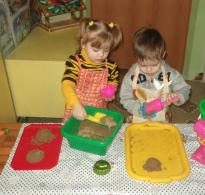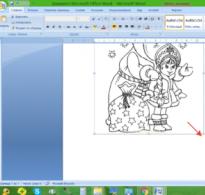Drawing with sand on glass is beneficial for children. Sand drawing or magic sand in the hands of a child. The quality of the sand will determine the beauty of your creations
Remember the feeling of being on the beach in summer. For example, you are sitting on the sand. Your hands are just reaching out to dive into the sand, rummage, wander in the sandy abyss. Then, in one motion, you scoop up a handful of sand and release it through your fingers. Billions of billions of grains of sand fall in streams, and it becomes so calm, such peace in the soul, that it even seems as if all worries go away with these golden streams. Miracle!
Why do children need to draw with sand?
Sand painting is also called sand therapy. More than 30 years ago, psychologists in the United States drew attention to the fact that art classes (painting lessons) with sand had a positive effect in treating people who had experienced psychological trauma or were in a depressed state. Nowadays, many children's development centers and family clubs organize sand activities to not only teach children and adults how to draw, but also to lift their spirits.
What are the positive aspects of working with sand?
1. The child develops an interest as a researcher. After all, the activity is usually surrounded by mystery. It's almost like conducting a scientific experiment or a magical ritual. A special backlit plane is set up for drawing. And they don’t give you paint at all, but sand (!), which pours out and at first is completely impossible to “tame.” And the sand may not be ordinary, but tinted.
2. The feeling of sand in your hands is relaxing. Sand is a living material; you can touch it with your finger, stroke it with your whole palm, and feel the hardness of every grain of sand on your skin. During the lesson, nerve impulses are transmitted from the skin to the brain, and the baby is “recharged”, like a battery, with good energy. Creativity with sand allows you to relieve anxiety and phobias. Emotional “clamps” go away and the body is reborn.
3. The child fantasizes with sand more boldly than on paper with pencils or paints. Here you can draw, correct and draw again, without the fear of making any mistakes, without the disappointment of “oh, it didn’t work out again!” The kid can sift the sand, collect it in a pile, level it, pick it with his finger, depict primitive sticks, “scribbles” or entire pictures, and then break everything and create again! Dozens of different actions and dozens of design variations in a relatively short period of time.
4. Drawing with sand helps develop fine motor skills. Experts say that this technique is even more effective than finger gymnastics. Why is that? Because tasks with sand put more strain on both the brain and muscles. For comparison, you should just try pouring sand in an even stream or drawing two identical suns with both hands to the left and right of the imaginary center line.
How to do sand therapy with your child
If you have the opportunity to enroll in a sand painting or sand therapy group, that’s great! Walk with your child and enjoy every lesson. As they say, company is always more fun. The level of tasks with sand, of course, will depend on the age of the child, and a child psychologist or teacher will tell you this. Although you can set up a sand painting studio at home.
Task one. Making a table for sand.
To make a special stand table with your own hands, you need to look for: a box, plexiglass, an electric lamp.
The table should be strong and stable. Therefore, it is best to take a small wooden box, knocked together from smoothly hewn and tightly fitted boards (chipboard is also suitable). This will be the tabletop. Attach the legs to the table - two identical bars or the legs of a children's stool.
Plexiglas is the safest of all options. Only let its dimensions (width and length) be slightly smaller than those of the box. The glass will be placed inside the table, so you need to make a rectangular “window” in the bottom of the box. If the glass is transparent, then it must first be painted on one side (you can seal it with a film that allows light to pass through). To secure the glass above the hole, use either slats, liquid nails, or adhesive tape.
Now we install the table, place the light source (lamp or flashlight) below, under the tabletop, and check the design in operation.
Task two. We extract sand.
Sand can be bought at the construction market, dug up in a children's sandbox, or brought from the sea. In any case, if your sand has the most noble origin, you need to bring the material “to mind”, namely: carefully check for the presence of debris, even sift, rinse and bake in the oven (not for long - enough for 1.5-2 hours) .
Children, especially girls, love to use clam shells, buttons, beads, pebbles and glass for decoration to decorate their designs. Prepare enough of this too.
Task three. We stock up on ideas.
How to get your child interested in sand painting? And there are various interesting options.
For the first time, you can prepare everything, but do not give away your secret, that is, do not explain in advance what you are going to do. Play an audio recording of a fairy tale, or nature music, or just your child’s favorite melody. And start drawing. Watch your child’s reaction and allow him to intervene if he suddenly thinks that the drawing needs to be corrected.
Or so. First, look for videos of sand therapy sessions. Watch with your child, and then try to do everything yourself. Or let the child draw by himself, modifying what he sees as he goes. Experiment!
Mariella Seitz's book “Writing and Drawing in the Sand”
Do you think you will be able to create beautiful sand drawings from the first lesson? This is not entirely true, unfortunately. Not even all adults create good drawings, let alone children.
If you are really interested in trying it out yourself, then first find and read a book called “Writing and Drawing in the Sand,” written by German teacher Mariella Seitz. This is a unique guide! In an accessible and very interesting way, the author shares tips on how mothers and fathers can learn to draw with sand themselves and how to teach children different drawing techniques.
What child doesn't like to play in the sand? But this seemingly simple entertainment for many generations of children has a deep psychological basis that influences self-development. Therefore, sand therapy today is an effective way to help a preschool child grow into a harmonious and holistic personality.
The essence of sand therapy, its advantages and disadvantages
Pictures on the sand are a model of a child’s world
Sand therapy is a study of a child’s behavior, an analysis of his experiences and a way to establish relationships with the world through playing with sand. Back in the 20-30s, followers of Carl Jung, who first assessed the informativeness of children’s behavior in the sandbox, began to develop methods for working with bulk material. In the 50s, child psychotherapist Dora Kalf systematized all scientific research in the field of studying the mental state of a child through his games with sand. According to her findings, the child builds his own model of the world in the sandbox, displaying all his worries, fears and experiences. In terms of information content, sand creations can be no less valuable than drawings. In addition, in the sand, the baby himself places the emphasis on the behavior and actions of the characters, and this helps him find the right decisions in life. In addition, sand:
- develops fine motor skills;
- opens up wide scope for the manifestation of imagination;
- help regulate the mechanisms of thinking.
Sand therapy helps:
- better express your thoughts when explaining sand creations;
- learn to take responsibility for your actions and actions;
- rely on one's own strength;
- develop self-esteem;
- overcome the consequences of psychological trauma.
- for allergy sufferers;
- those suffering from epilepsy;
- experiencing attention deficit.
The impact of therapy on preschoolers
Sand develops fine motor skills of fingers
The project to introduce sand therapy as a compulsory activity in preschool institutions is included in the Education Modernization Program for the next 2 years.
For kids, sand is not only a way to have fun with a pleasant natural material. The therapy has quite practical significance for the mental and physical development of children who will go to school in the near future. Namely, exercises with sand help:
- master numbers and letters;
- distinguish between “right” and “left”, day and night;
- navigate the seasons;
- train memory;
- develop visual-figurative thinking.
As a rule, group classes with sand begin at 3 years old - the age when the child goes to kindergarten. But individual lessons at home with mom and dad can begin from the moment when the baby stops putting everything in his mouth and begins to show interest in playing in the sand.
Sand play stages
By paintings on the sand you can determine the emotional state of the baby
Scientists have identified three stages of a baby playing with sand:
- Chaos. This is the stage when there are no differences between the figures on the playground, that is, it is not clear who they are: animals, people, plants. Such handling of bulk material indicates that the child is anxious and excited.
- Struggle. At this stage, the baby clearly divides characters into good and bad, and the predominance of the latter can be quite significant. This is a period of internal struggle in the child’s soul. Psychologists advise not to rush your child to change the plot of the game by adding positive characters. He must come to this himself.
- Exodus. This is the last, final stage of therapy. It means that the child is balanced, calm and at peace with himself.
Preparing to work with sand
You need to allocate a cozy place in the room for a box of sand.
To practice with bulk materials at home, you need to make a special play area. To do this you will need:
- flat wide box about 7 cm high;
- blue paint;
- watering can and small bucket for water;
- small various toys (metal, plastic, no more than 10 cm high), pebbles, shells.
Check that there are no sharp corners or nicks in the box. The inside of the box must be painted with paint that will evoke calm associations with water or the sky. If you have the opportunity to allocate a table for studying, then it should be smooth, and its height should be suitable for the height of the child, so that you can work both sitting and standing. As for sand, it is better to leave the choice up to the baby. But it is recommended to take warm yellow shades. It also doesn’t hurt to have a few dark ones to create contrasting scenes.
Exercises
The main goal of the exercises is to introduce the child to sand.
There is a set of exercises that allow children to better get used to new unusual material.. As a rule, these manipulations are used at the dating stage.
- Ask your child to place his hands on the sand and describe how it feels.
- Let your child draw a snake with his fingers, making beautiful wavy lines.
- Pouring sand from the fist into the sandbox also helps to get a better feel for the material.
- Invite your baby to say hello to the sand with each finger. To do this, let him put his palm in the sandbox and close his eyes. And you pour sand on each finger, the baby’s task is to guess which finger the sand is poured on.
Classes
Children's work in the sand can be individual or group. If classes involve the interaction of several people, then there must be an adult who will coordinate the contribution of each participant. For example, you can invite kids to build a fairyland. Each participant chooses a construction project and works on it, without interfering with others, but correlating their actions with others.
Games
When working individually, you can master several basic games:
- "Guess what." Bury a figurine in the sand and ask your child to guess who it is. To do this, give suggestive characteristics of the object.
- "Funny stories." Together with your child, come up with a funny story for the figures in the sand, and put some key words in letters of the alphabet. Then ask your child to turn away while you scatter the letters across the sandbox. The task for the baby is to unearth the letters and add up the lost words.
- "My dream city". Invite your child to build a city in which he would like to live. You definitely need to name all the characters and come up with stories for them.
Video: Developing fine motor skills with sand
Sand therapy allows not only the full development of the baby, but also eliminates psychological problems. This is also a great way to spend time with your beloved child, learn about his concerns and show that you love him and accept him in any mood. Joint creativity in the sand helps develop a child’s character, self-confidence and strength.
This trend arose relatively recently, but has begun to gain increasing popularity. Thanks to sand painting, children become more relaxed, get rid of some inhibitions, relax, and forget about some of their worries. Therefore, this creativity has a lot of positive aspects. The child fully surrenders to the world of beautiful fantasies, where kings, queens, castles, and dragons can live.
The online children's goods store https://nosorog.net.ua/ now has kinetic sand on sale, which will bring many pleasant moments to your child. Exercises with such sand help the child cope with his fears, phobias, and feel better mentally. He can do anything with a fictional world. Didn't like the palace? Not scary. You can easily depict a new one. You can correct and draw again all the time. The kid will understand that if something doesn’t work out somewhere, then it can be fixed.
Also, such drawing develops coordination of movements, fine motor skills, and trains the joint work of the brain hemispheres.
What you will need for classes
Firstly, this is the sand itself, and secondly, the table. Sand can be replaced with semolina. But the most ideal option would be colored sand, which can be found in stores.
By the way, you can either buy a table or make it yourself. And it's not difficult at all. To do this, you will need a wooden box with low sides and plexiglass. You will need to cut a small window in the bottom of the box, which should be covered with plexiglass. And on top of it put a regular white sheet of paper, which will need to be attached with tape.
Such a homemade table should be placed on a stand, and a light lamp should be placed under it. Everything is ready to start classes.
Where to start?
It is possible that this is something new and completely unknown for the baby. Therefore, first you can find and show him some videos in which specialists will create from sand. After watching, it is quite possible that your child will show interest in this art.
You can show him what manipulations can be done with sand, for example:
- pass through fingers;
- make holes in it;
- level;
- rake in different directions;
- create patterns using fingerprints.
By drawing with sand, the baby will be able to learn to reflect his thoughts and experiences. Over time, when he masters the basics of art, it will be possible to add all kinds of subjects to his classes. Let him create the way he wants, the most important thing is that it gives him pleasure.
It is difficult now to find a person who has not heard of sand animation. Many have probably seen the performances of sand artists in various talent shows. And hardly anyone will argue with the fact that sand animation is an extraordinary and fascinating spectacle. Under the artist’s hands, various paintings are born and replace each other, as if growing from one another. And well-chosen music is harmoniously woven into the plot, accurately conveying the mood of the moment. Therefore, it is not surprising that even simple and uncomplicated stories drawn with sand touch people to tears.
But sand animation is not only an unusual, beautiful cartoon drawn in front of the viewer. Sand painting is extremely beneficial. It’s not for nothing that many psychologists and psychotherapists include sand therapy in their nervous system treatment program. And for children, such activities will not only be very useful, but will also bring a lot of delight and joy.
All children, without exception, love playing with sand. Finding themselves at the sandbox or on the beach, they immediately begin to sculpt “pies”, make “cakes” or build sand castles, towers and fortresses. Adults also often join in this activity, and do it with pleasure. And just running warm soft sand through your fingers is very pleasant.
Drawing with sand brings children not only pleasure, but also great benefits. Experienced pediatricians claim that fine motor skills and speech development are directly dependent on each other. In other words, the better a child controls his fingers, the better he will speak. And sand animation develops not only fine motor skills, but also plasticity, general coordination of movement, as well as fantasy, imaginative thinking, imagination and creative abilities of the child. In addition, it is advisable to involve hyperactive children in such activities. Drawing sand patterns is very exciting and, as a result, develops perseverance and helps to concentrate.
Children can make sand paintings quickly and easily. And mistakes in such paintings are corrected without a trace, unlike drawing with paint on paper or chalk on asphalt. This gives the child self-confidence, confidence in his capabilities and strengths, and increases self-esteem. Even those children who are not good at paper and pencil drawings draw on the sand very willingly and enthusiastically.
Of course, it is better to learn how to create sand patterns in a specialized studio, under the guidance of experienced artists. But if there is no such studio in your city (or there is a simple lack of money), you can independently build a table with lighting at home and collect sand from the nearest children's sandbox. And let the child have fun.
By the way, if you are afraid that your baby might accidentally eat sand, give him semolina for his first lessons. To create dark shades, you can add a little ground coffee. And then - look at the situation.
You can familiarize yourself with sand animation lessons.
Svetlana Bezzubova
"We draw sand and on the sand".
Childhood is the best time for development of abilities and revealing talents, and sand painting is a unique new art form that shows the versatility of everyone child. Work with sand- a wonderful psychological method that I use in my work with children. After all, the teacher’s task is to provide an opportunity to kid plunge into the world of childhood, be creative, spontaneous, see and accept yourself as different, feel like the author not only of this sand fantasy, but also the author of your life. Game with sand- the most versatile, exciting, interesting game for any child age. If we consider the pedagogical and psychological aspects of using sand- this is both a wonderful sensory material and an excellent material for visual creative activity, experimentation, design, creation, cognition... Child included in the game with sand with your whole being - emotionally, mentally and physically. At the same time, favorable conditions are created for children to show concentration, curiosity, passion, and also for relaxation. Mental and emotional reserves are activated.
Creating mental images, working with your hands and getting new impressions and pleasure - all this together underlies the healing effect for child, in which the head (mind, hands) are harmoniously united (body) and heart (soul). Ordinary sand is something incredibly magical and bewitching. Sand painting- a surprisingly interesting and very “live” activity for children and adults. Sand drawings provide an excellent opportunity to accept, reveal and express in creativity many facets of one’s own “I”.
In accordance with Federal Law "About Education" The main priority of education today is the personality-oriented interaction of the teacher with child: acceptance and support of his individuality, interests and needs, development of creative abilities and caring for his emotional well-being. The world surrounding a child becomes more diverse and complex from year to year and requires from him not stereotyped, habitual actions, but mobility of thinking, quickness of orientation, and a creative approach to solving various problems. Therefore, it is quite obvious that the issue of improving didactic techniques is quite urgent. Modern preschool education guides teachers towards the use of the most effective pedagogical technologies in educational practice, aimed to acquire the necessary knowledge, development logical thinking, speech of children, teaching them to find solutions in various problem situations. Speech is the most important function of the psyche. From how much developed Whether a child’s speech is rich and correct depends on whether he can easily, openly and freely express his thoughts, explore the world and fully communicate with the children and adults around him. Speech impairment to one degree or another always affects the child’s behavior and activities. Children with speech delay development Beginning to realize the shortcomings of their speech, they often become withdrawn, silent, and indecisive. A pedagogical view of the psychotherapeutic sandbox is a rather bright and effective solution to this issue.
When a child works with sand, I can say a lot about him to know:
State of fine motor skills (deftly, confidently picks up small toys or drops them, etc.);
Level of cognitive interest (examines toys, asks about unfamiliar objects, shares impressions about already familiar toys, etc.);
Level general awareness(how many items from the toy set are unfamiliar to him);
Ability to generalize (toys are arranged according to lexical topics);
Personal characteristics (temperament, anxiety, self-confidence, aggressiveness, general emotional condition).
Level speech development(sound pronunciation, grammatical structure of speech, vocabulary);
Level development gaming activity (toys are simply scattered in the sandbox, there is a simple plot or plot development);
Emotional development(how emotions are expressed, their adequacy to the situation, stability);
Family relationship style (dialogues between characters);
Level development such mental processes as voluntary and involuntary memory, perception of shape, color, size;
A little history.
Sand painting- the art is quite young, it appeared in the 70s of the twentieth century. The inventor of the style is the Canadian animation director Carolyn Leaf, who created the animated sand film “Sand, or Peter and the Gray Wolf.” Her works have spread throughout the world and won the hearts of many viewers and artists. Seemingly simple movements are transformed, thanks to sleight of hand, into a plot, telling a whole story... Later, many animators adopted her experience, they tried to create a dynamic sand film, that is, without editing, in one go. Their experience became very successful and laid the foundation for a new type of art - art sand painting. Due to its indescribable effect on the public sand painting immediately attracted the attention of psychologists.
And as a method of art therapy sand painting came into use only today. Technique sand painting has artistic and therapeutic benefits. Sand capable“ground” negative emotions, it carries within itself the possibility of transformation. This "conversation" of hands with sand gives a huge corrective resource effect.
Today, experts have already proven in practice the effectiveness of using the sand method. drawing for working with a variety of psychological problems. Sand method drawing successfully used by specialists in educational and development purposes: teaching the basics of reading, writing and drawing, development cognitive processes, broadening horizons and general awareness, development fine motor skills and coordination of movements, development imagination and creativity abilities. Unusually pleasant to the touch, sand makes it possible to relax, relieve stress, inner voltage, problems go away.
There are reasons why you should learn paint with sand, and this is not at all surprising - drawing with sand or sand animation has a number of positive moments:
1. Does not require large material costs. To try your hand at sand animation, all you need is clean, sifted sand and glass.
2. Beauty and plasticity. Easily changing image details, the finished image flows smoothly and dynamically into the next one.
3. Coping with stress: by manipulating bulk materials, a person gets rid of negative emotions.
4. Aesthetics. Completed sand drawings by a child allow you to show your imagination.
5. When working with sand on the plane, movements become measured, synchronized with the rhythm of breathing.
6. Working with sand listening to music simultaneously uses the visual, auditory and kinesthetic channels.
7. Technology helps develop motor skills, which is especially useful for children (because through stimulation of the fingers the brain develops). Paint it is possible with both hands symmetrically, that promotes harmonious development two hemispheres of the brain, and internal centering.
8. Drawing with sand or on sand affects the development of a child’s active speech.




Having studied this topic theoretically, together with my parents we made a table with lighting for sand painting. They included many games and activities into their work, which all the children in the group enjoyed. At meetings with parents, seminars were held on forms and methods development speech and fine motor skills preschoolers using sand painting techniques. This is necessary so that parents clearly understand the level of speech child development, knew about his individual characteristics and could help their children at home - develop and consolidate skills received in kindergarten.
Using this method every day, we have noticed positive results:
Actively develops phrasal and coherent speech, general and fine motor skills of the fingers;
Activated development higher mental functions, cognitive activity;
develops sensory perception, ability to play with sand, etc.. games;
The social and communicative process in children is formed;
Manipulative skills are formed (they turn the pages of a book more confidently, draw, fasten buttons, use a spoon and fork.);
Visual and auditory perception, attention, thinking, creative imagination, memory are improved.
Children who had poor speech skills began to talk more with adults and communicate more willingly with their peers.
According to parents, all children enjoy telling familiar poems and fairy tales at home.
I will definitely continue my work on studying and using directions"Sand painting".






